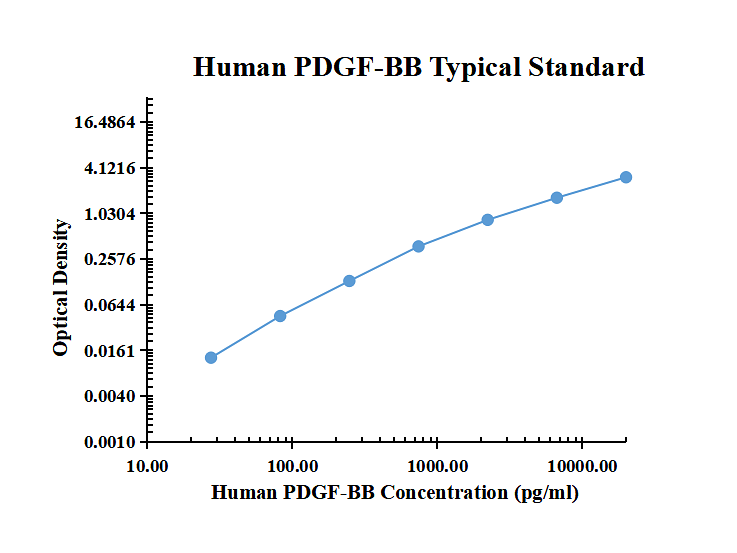Human PDGF-BB enzyme-linked immunoassay kit
| Specification | 96 Test |
|---|---|
| Sensitivity | 7.56 pg/ml (50 μl);2.79 pg/ml (10 μl) |
| Standard Curve Range | 27.43~20000 pg/ml |
| Standard Curve Gradient | 7 Points/3 Folds |
| Number of Incubations | 2 |
| Detectable sample | Liquid phase sample of soluble substances. For example: serum, plasma, cell culture supernatant, tissue grinding liquid, etc. |
| Sample Volume | 50 μl/10 μl |
| Type | Fully Ready-to-Use |
| Operation Duration | 120min |

| pg/ml | O.D. | Average | Corrected | |
|---|---|---|---|---|
| 0.00 | 0.0089 | 0.0079 | 0.0084 | |
| 27.43 | 0.0225 | 0.0201 | 0.0213 | 0.0129 |
| 82.30 | 0.0578 | 0.0504 | 0.0541 | 0.0457 |
| 246.91 | 0.1331 | 0.1487 | 0.1409 | 0.1325 |
| 740.74 | 0.3914 | 0.3825 | 0.3870 | 0.3786 |
| 2222.22 | 0.8560 | 0.8562 | 0.8561 | 0.8477 |
| 6666.67 | 1.5790 | 1.4540 | 1.5165 | 1.5081 |
| 20000.00 | 3.1680 | 3.0260 | 3.0970 | 3.0886 |
Precision
| Intra-assay Precision | Inter-assay Precision | |||||
| Sample Number | S1 | S2 | S3 | S1 | S2 | S3 |
| 22 | 22 | 22 | 6 | 6 | 6 | |
| Average(pg/ml) | 388.0 | 1692.3 | 5668.5 | 404.0 | 1977.6 | 5851.8 |
| Standard Deviation | 11.4 | 74.7 | 142.2 | 11.8 | 43.6 | 106.6 |
| Coefficient of Variation(%) | 6.0 | 4.4 | 5.3 | 5.8 | 4.5 | 3.7 |
Intra-assay Precision (Precision within an assay) Three samples of known concentration were tested twenty times on one plate to assess intra-assay precision.
Inter-assay Precision (Precision between assays) Three samples of known concentration were tested six times on one plate to assess intra-assay precision.
Spike Recovery
The spike recovery was evaluated by spiking 3 levels of human PDGF-BB into health human serum sample. The un-spiked serum was used as blank in this experiment.
The recovery ranged from 91% to 112% with an overall mean recovery of 103%.
Sample Values
| Sample Matrix | Sample Evaluated | Range (pg/ml) | Detectable (%) | Mean of Detectable (pg/ml) |
|---|---|---|---|---|
| Serum | 30 | 217.26-1712.20 | 100 | 608.29 |
Serum/Plasma – Thirty samples from apparently healthy volunteers were evaluated for the presence of PDGF-BB in this assay. No medical histories were available for the donors.
Product Data Sheet
Background: PDGF-BB
Platelet-derived growth factor (PDGF) was discovered as a major mitogenic factor present in serum but absent from plasma. It was found to be secreted from the alpha ‑granules of platelets activated during the coagulation of blood to form serum. Subsequent studies have demonstrated that PDGF is not one molecule but three, each a dimeric combination of two distinct but structurally related peptide chains designated A and B. The dimeric isoforms PDGF-AA, AB and BB are differentially expressed in various cell types and their effects are mediated through two distinct receptors, termed alpha and beta. Differences exist in isoform binding to each receptor. In general, PDGF isoforms are potent mitogens for connective tissue cells, including dermal fibroblasts, glial cells, arterial smooth muscle cells and some epithelial and endothelial cells. In addition to its activity as a mitogen, PDGF is chemotactic for fibroblasts, smooth muscle cells, neutrophils and mononuclear cells. Other reported activities for PDGF include stimulation of granule release by neutrophils and monocytes, facilitation of steroid synthesis by Leydig cells, stimulation of neutrophil phagocytosis, inhibition of natural killer (NK) cell activity, stimulation of collagen synthesis, modulation of thrombospondin expression and secretion, stimulation of collagenase activity and secretion, induction of contraction of rat aorta strips in vitro, and transient induction of T cell IL-2 secretion accompanied by a down-regulation of IL-4 and IFN-gamma production, temporary effects that may allow clonal expansion of antigen-activated B and T helper lymphocytes prior to differentiation. PDGF also appears to be ubiquitous in neurons throughout the CNS, where it is suggested to play an important role in neuron survival and regeneration, and in mediation of glial cell proliferation and differentiation.

